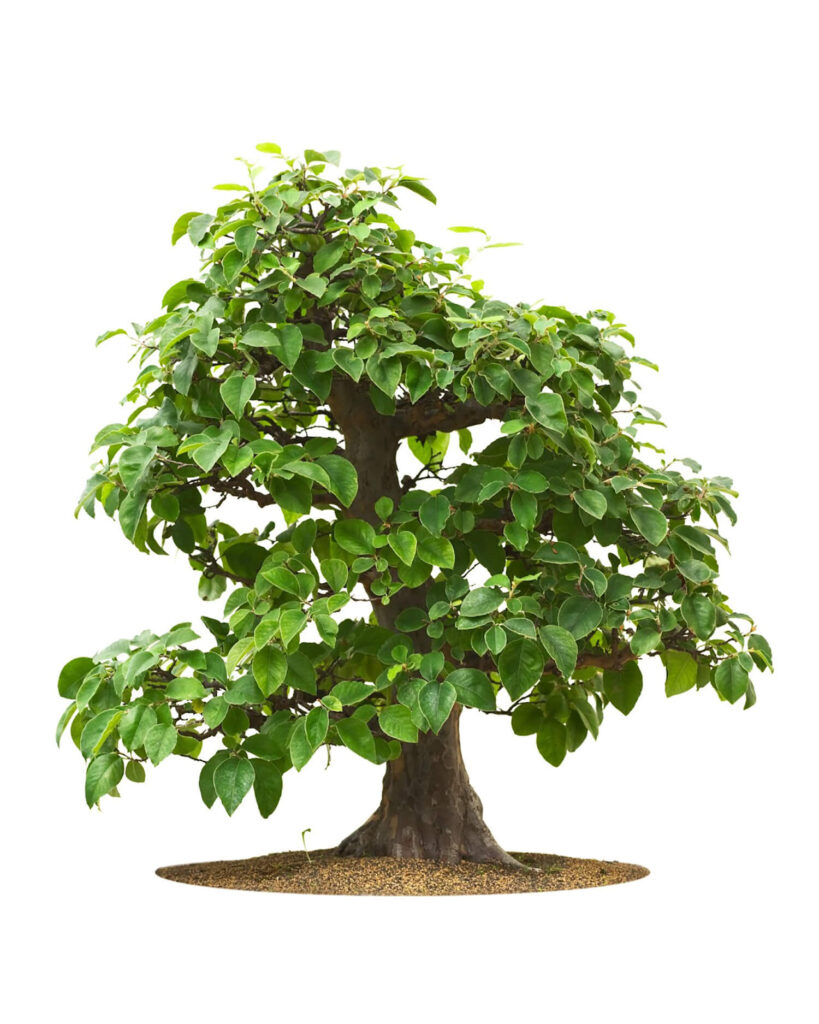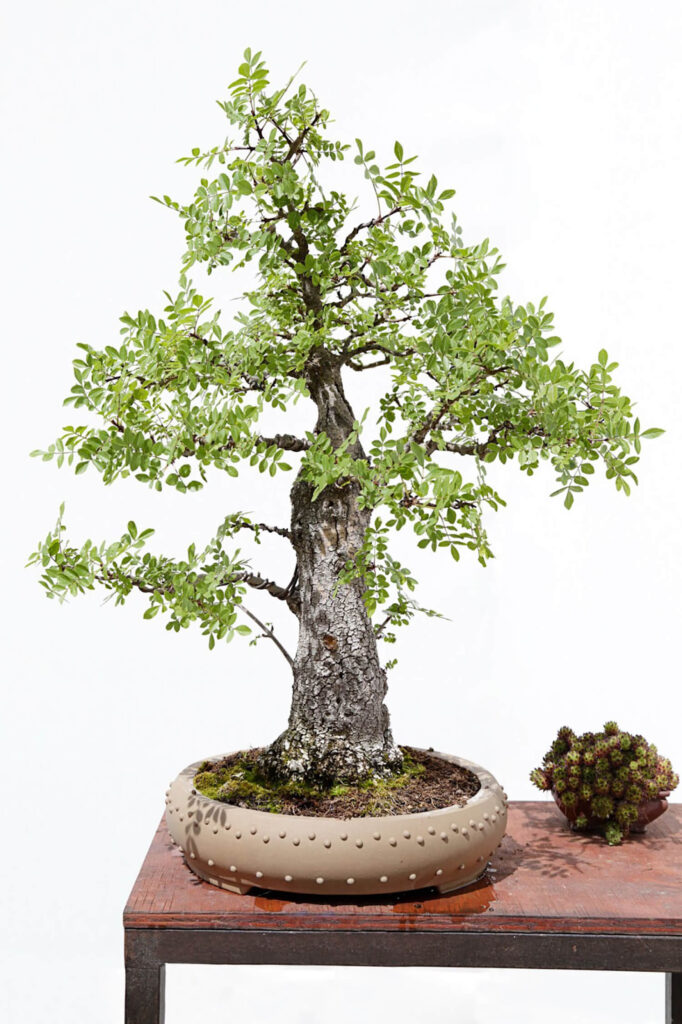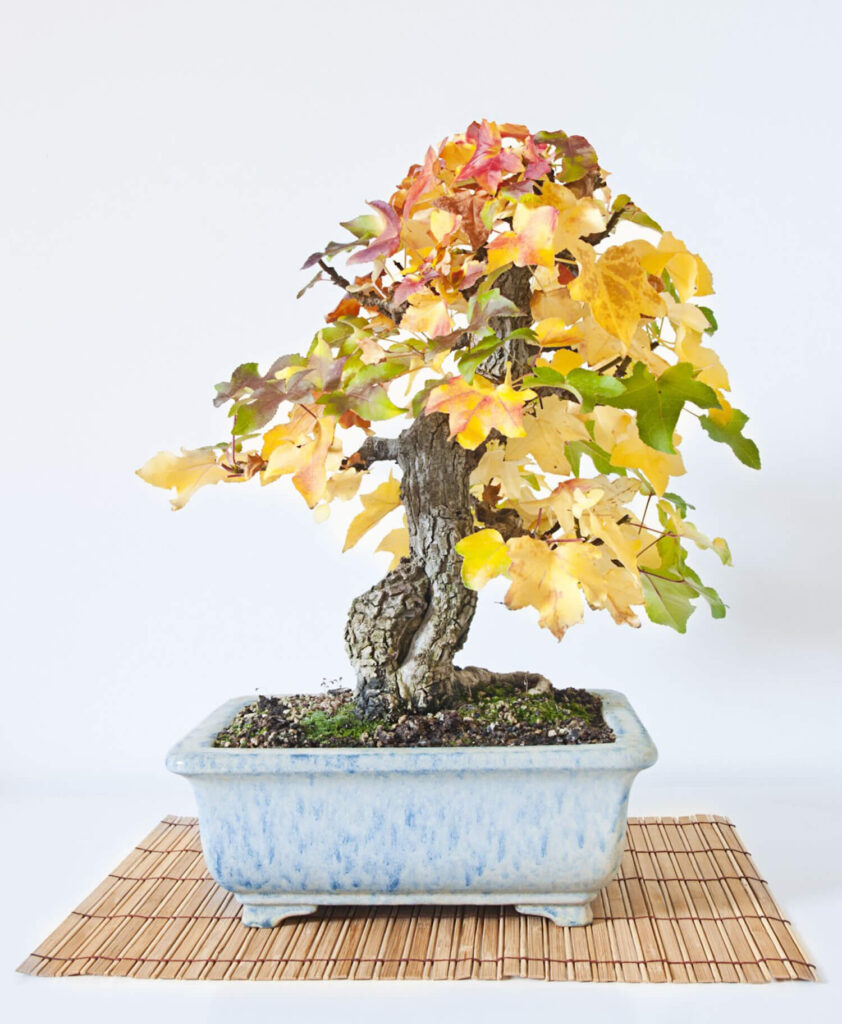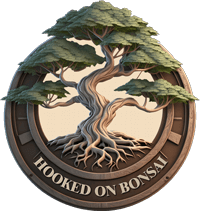Deciduous bonsai trees offer a dynamic canvas for bonsai enthusiasts of all levels. These trees, known for their seasonal leaf shedding and changing foliage colors, captivate both beginners and advanced growers alike.
In this article, we’ll explore the beauty and intricacies of various deciduous bonsai species, catering to both novices and seasoned practitioners.
If you’re wondering which deciduous tree species makes a great bonsai, We’ve created a list below to help people know which ones are best suited for you!
Understanding Deciduous Bonsai
Deciduous bonsai trees are a type of miniature tree that naturally shed their leaves in response to seasonal changes. These trees are characterized by their vibrant foliage, which undergoes color changes throughout the year, from lush greens in spring and summer to fiery reds and oranges in autumn. Deciduous bonsai species thrive best in temperate regions with distinct seasons, where they can experience the full spectrum of weather conditions. They require adequate sunlight and regular watering to maintain their health and vitality.
Selecting Deciduous Bonsai Species
When selecting deciduous bonsai species, several factors come into play to ensure a successful cultivation experience. One crucial consideration is the local climate, as different species thrive in specific temperature ranges and seasonal variations. For instance, Japanese maple bonsai prefer cooler climates with mild summers, while species like Chinese elm tolerate a wider range of conditions.
Additionally, enthusiasts should consider the desired size and aesthetic characteristics of the bonsai, such as leaf shape, bark texture, and branch structure. Popular choices among enthusiasts include Japanese maple, Chinese elm, and hornbeam, prized for their ornamental foliage and graceful forms.
7 Best Deciduous Bonsai Tree Species for Beginners
While there are a lot of deciduous tree bonsai species around the globe, not all are suited for bonsai growing.
If you’re looking into growing one, here are several deciduous options for you:
1. Chinese Elm

| Botanical name: | Ulmus Parvifolia |
| Other names: | Lacebark elm, Drake elm |
| Tree type: | Broadleaf deciduous |
| Native habitat: | Grasslands of East Asia (mostly China, Japan, and Korea) |
| Placement: | Both indoors and outdoors |
| Cost range: | $30 to $275 |
Chinese elm is a beginner-friendly bonsai tree species.
It has small, glossy leaves which sometimes turn yellow before they drop during winter or autumn. Partner it with fine branch ramification; then, you’ll have an attractive bare tree to display in winter.
Furthermore, the trunk of mature Chinese elm trees develops scaling bark with orange patches, which adds visual age to it.
Pros:
- Extremely robust
- Can endure some frost
- Tolerates aggressive pruning
- Tolerates a wide range of site conditions
Cons:
- Prone to scale and spider mites
- Doesn’t tolerate prolonged drought
2. Japanese Elm

| Botanical name: | Zelkova serrata |
| Other names: | Japanese Zelkova, Keaki, Japanese gray bark elm |
| Tree type: | Broadleaf deciduous |
| Native habitat: | Japan, Korea, and Taiwan |
| Placement: | Both indoors and outdoors |
| Cost range: | $25 to $295 |
Get a Japanese elm tree if you want to achieve a broom-style bonsai effortlessly.
This tree species has a straight trunk, slender branches, and twigs that fan out—making it easy for artists to style it as broom-shaped.
Another interesting thing about the Japanese elm is its narrow, dark green leaves that turn purple, red, yellow, or orange during autumn.
Pros:
- Tolerates light frost
- Non-susceptible to pests and diseases
Cons:
- Doesn’t like very calcareous water
3. Trident Maple

| Botanical name: | Acer Buergerianum |
| Other names: | Three-toothed maple |
| Tree type: | Broadleaf deciduous |
| Native habitat: | China, Japan, and Taiwan |
| Placement: | Outdoors only |
| Cost range: | $35 to $2950 |
As the name suggests, trident maple has leaves with three pointed lobes.
These orange-tinge leaves unfold in spring and then turn green over the summer. After that, they change to yellow, orange, and red in autumn.
This species also forms a thick trunk and wide nebari quickly. Moreover, its bark turns from smooth and gray to flaky with cinnamon-colored patches over time.
Pros:
- Strong root growth
- Tolerates heavy root pruning
- Non-susceptible to pests and diseases
Cons:
- Limited frost-hardiness
4. Chinese Quince

| Botanical name: | Pseudocydonia sinensis |
| Tree type: | Broadleaf deciduous |
| Native habitat: | East Asia |
| Placement: | Outdoors |
| Cost range: | $40 to $880 |
Fruit-bearing trees like the Chinese quince can also be cultivated as bonsai.
This tree has smooth, dark brown bark that peels off once the branches thicken. It also has oval-shaped, dark green, glossy leaves that turn orange or red in autumn.
Before the yellow fruits appear, this tree produces pink flowers in spring.
Overall, Chinese quince bonsai has a great aesthetic appeal regardless of the season.
Pros:
- Endures some frost
- Produces edible quince fruits
Cons:
- Prone to bacterial infection (scale, aphids, fire blight, and weevils)
5. Redwood

| Botanical name: | Sequoioideae |
| Tree type: | Coniferous deciduous/evergreen |
| Native habitat: | China and Northern California & Oregon, respectively |
| Placement: | Outdoors |
| Species to get: | Dawn Redwood (Metasequoia glyptostroboides) and Coast Redwood (Sequoia sempervirens) |
| Cost range: | $50 to $595 |
Redwood is the tallest upright bonsai species in the world, so it’s best suited as an ogata (large) bonsai than a shohin (small).
As its name suggests, it has a reddish-brown, scaly bark. It also produces small, round cones and has soft, light green needle-shaped foliage.
One notable thing about the dawn redwood species is that it’s quite similar to bald cypress. The only difference is that the former has an opposite leaf pattern.
Pros:
- Fast growing
- Strong root growth
- Produces lots of new buds
- Tolerates pruning very well
- Hardly susceptible to pests and diseases
Cons:
- Growth isn’t easy to control
6. Desert Rose

| Botanical name: | Adenium obesum |
| Other names: | Japanese frangipani, Adenium |
| Tree type: | Broadleaf deciduous |
| Native habitat: | Africa and Arabia |
| Placement: | Both indoors and outdoors (as long as the temperature is warm) |
| Cost range: | $15 to $350 |
Although it’s not typically cultivated as a bonsai, it makes an interesting piece.
The desert rose is a small succulent tree that develops a bulbous base and has fleshy leaves capable of storing water. Usually, these leaves fall off in winter.
Depending on the tree’s condition, it can produce large white, pink, or red flowers from summer until fall.
Pros:
- Grows vigorously
- Requires little watering
- Adapts easily as a bonsai
Cons:
- Needs lots of light
- Have poisonous milky sap
- Branches are prone to scarring
- Have to be kept in a warm environment
7. Chinese Pepper Tree

| Botanical name: | Zanthoxylum simulans |
| Other names: | Szechuan pepper, Sichuan pepper |
| Tree type: | Broadleaf deciduous |
| Native habitat: | Himalaya, China, Japan, and Korea |
| Placement: | Thrives indoors, but can be kept outdoors in a warm climate |
| Cost range: | $19 to $295 |
Do you want something that offers other uses? Then, grow a Chinese pepper tree bonsai.
This subtropical tree has small, glossy paripinnate leaves and thorny trunk and branches.
Moreover, it produces edible peppers that you can use to add spice to your home-cooked dishes. These peppers are known as “Sichuan peppercorns.” They appear green when unripe and red when fully ripe.
Pros:
- Grows vigorously
- Can be propagated easily
- Produces Sichuan peppercorns
Cons:
- Thorny
- Don’t tolerate stagnant moisture
- Prone to spider mites during wintertime
8 Different Deciduous Bonsai Trees for Advanced Growers
Make your garden or home look more appealing by adding a deciduous tree to your growing collection.
To help you decide which one to grow, here are some of the best intermediate deciduous tree species:
1. Bald Cypress

| Botanical name: | Taxodium distichum |
| Tree type: | Coniferous deciduous |
| Native habitat: | South parts of the US, Mexico, and Guatemala |
| Placement: | Thrives outdoors |
| Cost range: | $24 to $1295 |
The bald cypress is a tall tree with a reddish-brown, fibrous trunk. Once it matures, the bark turns grayish brown and furrowed.
This deciduous species has soft, green needles that change to an auburn color in autumn. Since this is a deciduous tree, these auburn-colored needles fall off along with some small twigs in the fall.
One interesting thing about bald cypress is that it sometimes develops cypress knees that add valuable appeal to the bonsai—these are woody structures above the soil that appear from the root system.
Pros:
- Strong root growth
- Produces lots of new buds
- Non-susceptible to pests and diseases
Cons:
- Must be watered often
- Requires winter protection
- Needs lots of light and warmth
2. Japanese Maple

| Botanical name: | Acer palmatum |
| Tree type: | Coniferous deciduous |
| Native habitat: | Japan, Korea, and China |
| Placement: | Thrives outdoors |
| Varieties to get: | Katsura, Arakawa, Deshojo, Shishigashira, Atropurpureum, Seigen, and Kiyohime |
| Cost range: | $40 to $1830 |
Japanese maple is one of the most popular hardwood bonsai materials.
One of its well-loved features is its colorful autumn leaves, which can appear yellow, orange, or red, depending on the variety. Eventually, these hand-shaped leaves fall off in winter.
In late spring, it produces red clustered flowers. After that, winged seeds called samara—which look like little propellers—appear.
Aside from these, the Japanese maple is also known for its fine branching and bark that changes from reddish to grayish as it ages.
Pros:
- Frost-hardy
- Very sturdy
- Strong root growth
Cons:
- Doesn’t like calcareous water
- Susceptible to pests and diseases
Check out: Extensive Care Guide for Japanese Maple Bonsai
3. Hornbeam

| Botanical name: | Carpinus |
| Tree type: | Broadleaf deciduous |
| Native habitat: | Cool temperate regions of East Asia and Europe |
| Placement: | Outdoors |
| Species to get: | Oriental hornbeam (Carpinus orientalis), Japanese hornbeam (Carpinus japonica), Korean hornbeam (Carpinus turczaninovii), Loose-flower hornbeam (Carpinus laxiflora), Silky hornbeam (Carpinus tschonoskii), European hornbeam (Carpinus betulus), and American hornbeam (Carpinus caroliniana) |
| Cost range: | $60 to $2988 |
Although hornbeam is often mentioned with beech, it actually belongs to the birch family.
This tree has vividly green leaves that turn golden yellow or orange before they fall off. On some occasions, dry leaves stay attached to the twigs until next spring, which makes this deciduous tree look more interesting.
Unlike the other species, hornbeam produces hanging catkins in spring. These catkins then turn into winged fruits that remain hanging throughout the summer.
Pros:
- Very frost-hardy
Cons:
- Prone to root rot and chlorosis
- Doesn’t like very calcareous water
- Highly susceptible to pests and diseases
4. Beech

| Botanical name: | Fagus |
| Tree type: | Broadleaf deciduous |
| Native habitat: | Japan and Central Europe |
| Placement: | Outdoors |
| Species to get: | Japanese white beech (Fagus crenata) and European beech (Fagus sylvatica) |
| Cost range: | $19 to $695 |
Similar to hornbeam, beech specimens have green foliage with bright autumn colors. Dry leaves sometimes remain on the twigs too.
However, unlike the former, it produces beech nuts. These are tiny spiky fruits that contain two or more edible nuts.
Its Japanese white beech and European beech species are generally similar. Except that the former has a smooth, silvery trunk, while the latter has a smooth, gray trunk.
Regardless, beech trees are known for their beautiful trunks.
Pros:
- Very frost-hardy
- Tolerates a wide range of conditions
Cons:
- Susceptible to pests
- Prone to chlorosis and root rot
- Doesn’t like very calcareous water
5. Larch

| Botanical name: | Larix |
| Tree type: | Coniferous deciduous |
| Native habitat: | Cooler areas of Northern hemisphere |
| Placement: | Thrives outdoors |
| Varieties to get: | Japanese larch (Larix kaempferi), European larch (Larix decidua), and Golden larch or Chinese larch (Pseudolarix amabilis) |
| Cost range: | $80 to $3355 |
Larch is a tall, coniferous, deciduous bonsai tree species.
Unlike most cone-bearing trees, its green needles turn yellow before they drop in the fall and winter.
In spring, it produces new, attractive buddings and small cones. These cones turn from purplish to brown as they ripen.
Other great features of Larch are its fine ramification and beautiful, flaky bark, which you can fully see in winter when the tree is bare.
Pros:
- Extremely hardy
- Grows thick trunks quickly
- Young trees are quite flexible
- Responds to pruning very well
Cons:
- Needs lots of water
- Doesn’t tolerate heavy root pruning
- Susceptible to various pests and diseases
6. Oak

| Botanical name: | Quercus |
| Tree type: | Broadleaf deciduous |
| Native habitat: | Southwest Asia, Europe, North Africa, and Central & North America |
| Placement: | Outdoors |
| Species to get: | European oak (Quercus robur) and American white oak (Quercus alba) |
| Cost range: | $39 to $19500 |
Oak is one of the strongest tree species with several great features ideal for bonsai.
For once, most of its heavy branches tend to naturally bend outwards. As a result, it creates an interesting branch system and wide crown.
Partner it with a thick, furrowed trunk. Then, you’d have a classic-looking deciduous tree species.
It also produces small acorns that are cultivated for various culinary uses. Also, its long, dark green leaves turn yellow or brown in autumn, which adds aesthetic appeal to it.
Pros:
- Frost hardy
- Can be propagated easily
- Very resistant to different climates
Cons:
- Doesn’t tolerate heavy root pruning
- Highly susceptible to powdery mildew
7. Ash Tree

| Botanical name: | Fraxinus |
| Tree type: | Broadleaf deciduous/evergreen |
| Native habitat: | Most temperate and some tropical zones globally |
| Placement: | Outdoors |
| Species to get: | Common ash (Fraxinus excelsior), Narrow-leafed ash (Fraxinus angustifolia), Manna ash (Fraxinus ornus), Oregon ash (Fraxinus latifolia), Chinese flowering ash (Fraxinus sieboldiana), and Himalayan ash (Fraxinus griffithii) |
| Cost range: | $90 to $606 |
Ash is one of the biggest tree species in Europe, so it’s more suitable as a large deciduous tree species.
It has dark green compound leaves that change to bright yellow in autumn before they drop. Then, in spring, it produces white flowers, followed by samara fruits similar to maples.
The interesting thing about the ash tree is that its gray bark develops diamond-shaped patterns as it ages. This specific feature makes ash unique and easy to identify.
Pros:
- Fast growing
- Thickens quickly
- Produces good ramification
Cons:
- Requires frequent pruning
- Needs some frost protection
- Susceptible to various pests and diseases
- Doesn’t tolerate long drought and constant wetness
8. Sweetgum

| Botanical name: | Liquidambar |
| Other names: | Gumball, Amber tree |
| Tree type: | Broadleaf deciduous |
| Native habitat: | China, Central & North America, Turkey, and the Greek Island Rhodes |
| Placement: | Outdoors |
| Species to get: | American sweetgum (Liquidambar styraciflua), Taiwanese sweetgum (Liquidambar formosana), Chang’s sweetgum (Liquidambar acalycina), and Oriental sweetgum or Turkish sweetgum (Liquidambar orientalis) |
| Cost range: | $50 to $235 |
Sweetgum is known for its bright autumn leaves and deeply furrowed grayish-brown bark.
Like maple, it has palmate-shaped leaves with three to seven lobes, depending on the species. These dark green leaves change to a yellow, orange, red, or purple color before they fall off.
It also grows upright flowers in spring, adding more color and life to the tree.
Moreover, it produces clustered capsule fruits covered in spikes. Once you succeed in opening one of them, it’ll reveal lots of small seeds. While they look interesting, these capsules aren’t edible, so don’t consume them.
Pros:
- Fast growing
- Grows vigorously
- Low maintenance
- Apex grows strongly
- Heat and drought-resistant
Cons:
- Branches are stiff
- Requires frequent trimming
- Needs protection from strong frost and harsh wind
Deciduous Bonsai Care
Deciduous bonsai care is essential for both beginners and advanced enthusiasts to ensure the health and longevity of these miniature trees. Watering is a fundamental aspect of care, with beginners advised to water thoroughly when the soil feels dry to the touch, while advanced enthusiasts may use moisture meters to monitor soil moisture levels more precisely.
Pruning is another critical task, with beginners learning basic techniques to shape their bonsai’s growth, while advanced enthusiasts may perform more intricate pruning to refine branch structure and promote ramification.
Additionally, both beginners and advanced growers should provide appropriate sunlight exposure and regular fertilization to support healthy growth and development. By understanding and implementing these care practices, bonsai enthusiasts can enjoy the beauty of their deciduous trees for years to come.
Conclusion
Deciduous bonsai trees offer an enchanting journey for enthusiasts, from novices to seasoned practitioners. By understanding each species’ unique traits, both beginners and advanced growers can cultivate these miniature marvels with joy. With careful watering, pruning, sunlight exposure, and fertilization, these trees thrive and flourish. Start with the basics if you’re new, then explore advanced techniques.
Embrace the journey, celebrate growth, and enjoy the serene beauty of your living masterpiece!






0 Comments